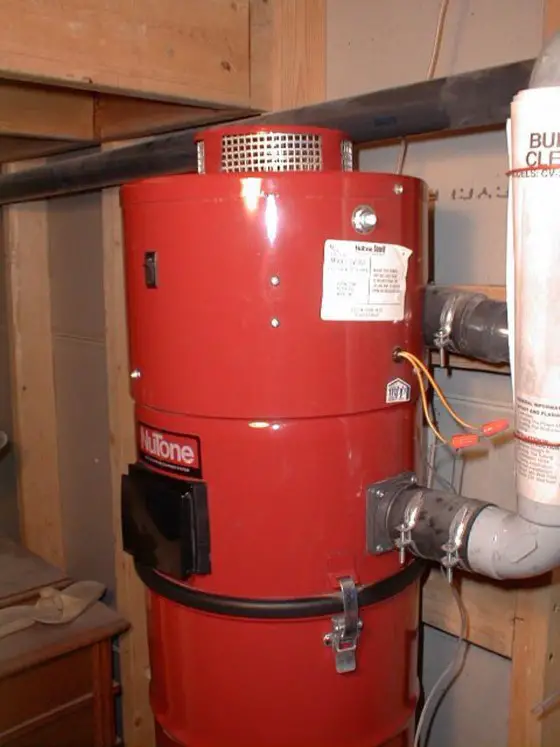Central Vac
DEAR TIM: I was touring a new home that was open. One of the features that really interested me was the central vacuum system. It seems like one of these would be really handy. What’s involved when you install a central vacuum? Can you share some tips, especially what not to do? I hate making mistakes. Ray H., Newtown, PA
DEAR RAY: I've been really lucky for the past twenty-five years in that the past two houses I've lived in both have had a central vac. I have to tell you that I don't know if I would be able to handle going back to a traditional hand-held vacuum that you have to lug around the house.

This is a rare site. Here’s what a central vac outlet looks like with the plaster or drywall out of the way. PHOTO CREDIT: Tim Carter
Perhaps the biggest misconception about central vacuum systems is the myth that they can only be installed when building a new home. That's simply not true. It's absolutely easier to install one when the walls are wide open, but believe me, a talented installer can put one in an existing home with relative ease.
When you toured that new home, you saw outlets on the walls that looked something like an electrical outlet. These have a door that flips open and the end of the central vac hoses plugs into the hole. Small metal contacts inside the outlet cause the remote motor in the vacuum to immediately turn on and you're ready to work.
The pipe in the walls is 2-inch diameter. The inner diameter of the flexible hose that you use to clean with is approximately 1 and 1/4 inches in diameter. This is by design so that it's virtually impossible for the hidden pipe in the walls to become clogged. If an object can pass through the flexible hose in your hands, it can make it through the walls to the actual vacuum canister.
There are any number of mistakes you can make when installing a central vac system. One is putting in too few outlets. You have to account for furniture being in your way, so the length of the flexible hose doesn't always reach as far as you might think. You'll never regret having too many outlets. The central vac parts to do this are pretty inexpensive.
You can really make a mistake where you locate the canister. Most systems have the motor and the canister as one unit. The motor can be pretty loud, so I highly recommend putting this out in your garage. The added benefit to this is when you empty the canister or replace the bag dust is kept out of your home.
Some installers will take a shortcut and not run the exhaust pipe outdoors. Don't fall into this trap. You want the air to exit the house in case it has very fine dust particles in it. The only way I'd not exhaust a central vac outdoors is if the manufacturer could promise me there would never be dust in my garage or basement. Always follow the instructions of the manufacturer. If they say to exhaust the machine outdoors, do it.
If you put your canister and motor in your garage, be sure there is an outlet on the machine. If not, then put in a regular outlet in a wall on the garage. It's so handy to be able to use the central vac to clean a car.
Perhaps the most common mistake I see when installers put in a central vac, and one that does exhaust outdoors, is NOT installing a fresh-air intake. A central vacuum consumes vast amounts of air when it's turned on and it needs to get that air from outdoors.

If you have a very tight home, the operation of a central vacuum could possibly cause backdrafting of combustion gases down metal chimneys or vents into your home which could cause carbon monoxide poisoning. It can also make a house smell like smoke if you have wood-burning fireplaces or wood stoves as the vacuum gets its replacement air by sucking it down a chimney.
Installing the piping for a central vac system in an average-sized new house usually only takes part of a day. The pipe glues together with regular PVC cement. You can cut the thin piping with a simple hacksaw, making sure you remove any burrs from the cut ends of the pipe. Burrs can grab onto hair and possibly lead to a clog years from now.
You have to also run low-voltage wire from the outlets back to the motor. This is very easy to do. Just use electricians tape to adhere this small wire to the side of the plastic vacuum piping.
Be sure you check your canister frequently to ensure that it's not full of dirt and debris. As the canister or bag fills with dirt, the suction power of the vacuum starts to drop. Use common sense and avoid picking up rocks or gravel with your central vac. Sweep up that with a regular broom.
I've not installed a Beam central vac, however I've put in quite a few Nutone and VacMaster units. Another popular brand is an Electrolux central vac. I'd always let price be my barometer in this situation as the better vacuum systems will almost always have better parts and motors. These cost more, so the total price of a better unit will almost always be higher than a cheap brand.
The column was mentioned in the April 28, 2011 AsktheBuilder Tips & Newsletter.
Column 871
One Response to Central Vac